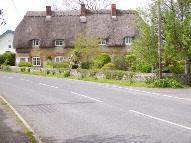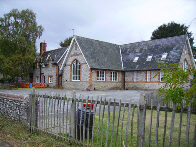Education
The country gentry were comparatively uneducated, and the poor could neither read
nor write in the seventeenth century, at that time there could ha ve been no school
in the village beyond the horn book class, where boys were taught rude discipline
rather than book knowledge. We have no record of a school till nearly a century after
the date of our first entry. And yet writing must have been familiar to some of the
yeomanry, or the record could not have been kept; unless it was done by the parson,
or by some competent person who was paid for the duty.
ve been no school
in the village beyond the horn book class, where boys were taught rude discipline
rather than book knowledge. We have no record of a school till nearly a century after
the date of our first entry. And yet writing must have been familiar to some of the
yeomanry, or the record could not have been kept; unless it was done by the parson,
or by some competent person who was paid for the duty.
The old school building, which stood on Swampton green, is now turned into cottages;
but the date on it was 1723. And from that date, if not earlier, it was a free school
in part up to 1835, when it was altered and improved, and from that date up to 1859
it became wholly a free school, and was liberally supported. It was supposed that
the Oxenbridge family had an endowment towards its support, but this it appears was
a mistake. The £15 paid annually, for the free education of twelve boys and six girls,
was the gratuitous and liberal provision of the various heads of the family of the
Earl of Portsmouth. The filling up of the vacancies in the school, under this gift,
was to be in the nomination of the tenant of upper Wyke farm for the time being.
Many years ago, and still remembered, the higher class people of the parish did not
think it beneath them to send their children to this school, at of course a proportionately
payment.
The present National school bear date 1860. They were erected by subscription, aided by a government grant. The Earl of Portsmouth was the principal donor, he having given the land. The piece of land was originally called square meadow, containing by estimation three roods and fourteen perches It was conveyed to the Reverend Watkin Temple Clerk of the parish of Hurstbourne, John William Hooper of Stoke, Esquire and Mr. Thomas Longman of Finckley. The entire cost of the building was £1100; and the late Mr. William Gue, of Andover, was the architect and builder. It was conveyed to be used as and for a school for the education of children and adults or children only of the labouring, manufacturing and other poorer classes in the parish of St. Mary Bourne. The declaration goes on to say, " And it is hereby declared that the instruction at the said school shall comprise at least the following branches of school learning namely Reading, Writing, Arithmetic, Geography, Scripture, History and in the case of girls Needlework. And it is hereby further declared that it shall be a fundamental regulation and practice of the said school that the Bible be daily read therein and that no child shall be required to learn any Catechism or religious formulary other than the Lord’s Prayer and the Ten Commandments. And it is hereby declared that no person shall be appointed or continue to be the master or mistress of the school who shall not be a member of the Church of England".
A north wing was added in 1878 as a classroom for infants. It cost £139.10s., the work being completed by Mr. William Batsford, of St. Mary Bourne.
The staff of the school has been as a rule; Under the National School Committee, one certificated master, a sempstress, one pupil teacher, and occasionally a paid monitor.
The first schoolmaster on record is Alexander Neave. He died about 1778, but his grave is lost. It is about twenty years since I observed his tombstone leaning against the north wall of the graveyard, were it had been placed by the direction of the vicar. There is a notice in the parochial books that Alexander Neave was one of the overseers of the parish in 1765, as well as schoolmaster. There is no doubt that for a time he kept the records. Previous to his death he resigned the school, and was succeeded by Richard and Ann Sutton, who held it until 1828. At the death of Ann Sutton it passed into the hands of Ann Longman, who dying in 1835, Moses and Sarah Butcher succeeded to the charge.
The following table taken from the church register, (Those who could sign the marriage
register), is intended to show the growth of education; and it may be looked on as
a considerable criterion in a rural population where the three Rs, (mostly minus
the arithmetic) embraced the curriculum during the greater portion of the period
from 1813 to 1887. Taking periods of 25yrs the figures read thus-
From 1813-
From 1837-
From 1862-
Replies to a visitation enquiry circa 1750 (finding no. 21M65/J2/4/9 H.R.O.)
Enquiries into the state of charity schools.
- Question 1. What is the name of the county parish and village where the charity school is?
- Answer; There is one charity school in the parish of Hursbourne Priors and another in the parish of St. Mary Bourne annext in the county of Southton.
- Question 2. What is the name of the master or mistress of it?
- Answer; William Munday is the present master of the school at Hursbourne Priors and Alexander Neave is the present master of the school at St. Mary Bourne.
- Question 3. What number of children is taught in it? Are they boys, or girls? And are they cloathed?
- Answer; At the school at Husbourne Priors are taught free all the poor boys of the parish and all the tenants sons belonging to Sir Berkley Lucy at the school at Bourne Twenty poor boys are taught free no girls are admitted at either school, no boys cloathed.
- Question 4. What are they taught? Are they employed in working, and of what kind?
- Answer They are taught to read and write and cast account, but are not employed in any work.
- Question 5.Are the children put out to husbandry, Trades, or Service? And how many have been put out to each of those employments, from the foundation of the school?
- Answer None of them are put out by any publik charity to any trade or service.
- Question 6.When was the school set up? How is it supported? By endowment, subscriptions, or accidental contributions?
- Answer The school house at Husbourne Priors was built by Sir Kingsman Lucey, father to the present Sir Berkley Lucey who endowed it with Twenty pounds per annum which Sir Berkley Lucey's estate is bound to pay.
- The school at St. Mary Bourne was built and founded in the year 1723 by the right Hon. the Lord Viscount Lymington who gives annually to the master Ten pounds and Ten Shillings as a free gift for taking in and instructing twenty poor boys of the parish of St. Mary Bourne in Reading, Writing and Arithmatic.